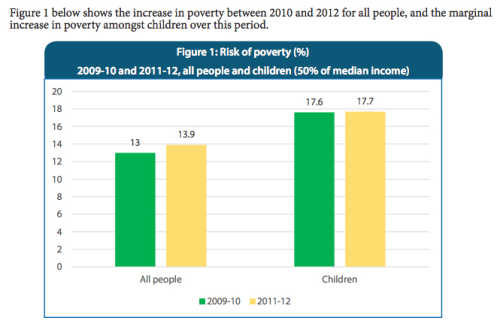There are more Australians living in poverty than there was in the GFC

One in seven Australians is living in poverty a report released by ACOSS revealed over the weekend, and one in six children are living in poverty and this is up on the last time poverty was analysed in our country, at the tail end of the GFC. So with older Australians facing higher risks than all but one other group, I want to talk about it today. Surely, as a nation, it is time we stood up for those doing it tough and provide some real solutions that make poverty disappear. But what do you think we can really do to make a difference?
We are a nation with great socio-economic opportunities. Through the GFC, our nation was one of the most resilient economies in the world. So it seems tragic that such a significant proportion of Australia is living below the breadline.
According to the report, the risk of poverty in our country is highest among people who rely mainly on social security payments for their income.
The social security safety net is vital for people who lose their job, fall ill, have a disability, separate from their partner, or retire, yet this report shows that the system is not doing its job to prevent poverty among people who experience these common life events. And even the fact that some might have paid work does not protect them from poverty: over 30% of the 2.55 million people living in poverty come from households where the main form of income is from wages and not social security.
14.8% of older people are battling to live below what is considered is to be enough earnings to comfortably survive on, which, by the OECD definition is $400 per week.
The report states that women are significantly more likely to experience poverty than men, with 14.7% of women living in poverty-considered conditions compared with 13% of all men experiencing poverty in 2011-12.
Compared with other age groups, children and older people face higher risks of poverty (17.7%
and 14.8% respectively), reflecting the higher costs facing families with children and the fact
that many older people receiving the Age Pension do not have sufficient additional income to
place them above the poverty line.
But, as we can see below, the pension could be part of the problem, with the maximum basic rate of the pension putting pensioners with no other assets or income, right on the poverty line.
| Family Situation | ||||
|---|---|---|---|---|
| Pension rates (per fortnight) | Single | Couple each | Couple combined | Couple each separated due to ill health |
| Maximum basic rate | $776.70 | $585.50 | $1,171.00 | $776.70 |
| Maximum Pension Supplement | $63.50 | $47.90 | $95.80 | $63.50 |
| Energy Supplement | $14.10 | $10.60 | $21.20 | $14.10 |
| TOTAL | $854.30 | $644.00 | $1,288.00 | $854.30 |
A fair go for all has always been “The Australian Way” yet 2.55 million Australians have not been getting a fair go and it presents a disturbing picture of what we, in our communities need to do to confront the issues that are frankly unfair in today’s society.
But what can we do? Can we rely on Governments alone to do our bidding? Is it their role to counteract poverty through budgeting, process and and policy? Or it is the role of everyone in society to step up and provide support, more support than we already do….
The ACOSS report insists that we must have a whole of community effort, involving business, unions, community groups, researchers and the general public in a national consensus to support our much cherished values of a fair go, opportunity for all, and caring for each other – values that have made us a strong prosperous nation. Poverty should not be inevitable in a country as rich as ours. It is our collective responsibility to build on our great wealth and ensure we fairly share the opportunities and include all our citizens.
So, how can we stop poverty? Let’s brainstorm the thing we can do inside our little worlds today…









 Proudly Australian owned and operated
Proudly Australian owned and operated